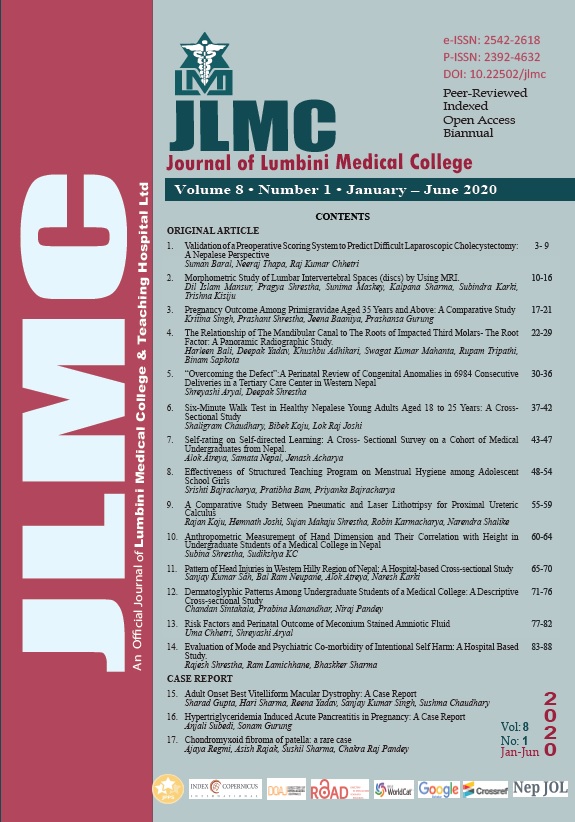Evaluation of Mode and Psychiatric Co-morbidity of Intentional Self Harm: A Hospital Based Study
Keywords:
Intentional self-harm, Psychiatric co-morbidity, Psycho-social, Self-poisoningAbstract
Introduction: Intentional self harm is a potentially self injurious action with a non-fatal outcome for which there is evidence, either explicit or implicit, that the individual intended to kill himself or herself. Suicide is a fatal act of self-injury (self harm) undertaken with more or less conscious self destructive intent. There has been an increase in the number of patients presenting with attempted suicide in the emergency settings of hospitals. This study aimed to explore socio-demographic characteristics, pattern of attempts, psychiatric diagnosis, psychosocial and personality factors among survivors of suicide attempt presenting to a tertiary care hospital.
Methods: The study included 100 survivors of intentional self harm registered over a period of six months visiting a tertiary care hospital. The cases directly presented to Psychiatry department and were referred from medical and other departments for psychiatric evaluation. They underwent evaluation by consultant psychiatrist and received appropriate interventions.
Results: Majority of the victims were female (73%), belonging to the age group of 20-40 years. The most common method of attempt was self poisoning with pesticides (65%) followed by hanging (16%) and overdose of drugs (7%). Most of the attempts (68%) were impulsive in nature. Mental illness was diagnosed in (65%) of the cases, mainly depressive disorder (51%), and personality disorder (10 %). Most of the attempts (67%) were triggered by psycho-social factors.
Conclusion: The pattern shows predominance of female gender, young age group, a role of mental illness, impulsivity and psychosocial factors in intentional self harm.
Downloads
Downloads
Published
How to Cite
Issue
Section
License
Copyright (c) 2020 Rajesh Shrestha, Ram Lamichhane, Bhaskker Sharma

This work is licensed under a Creative Commons Attribution 4.0 International License.
The Journal of Lumbini Medical College (JLMC) publishes open access articles under the terms of the Creative Commons Attribution(CC BY) License which permits use, distribution and reproduction in any medium, provided the original work is properly cited.JLMC requires an exclusive licence allowing to publish the article in print and online.
The corresponding author should read and agree to the following statement before submission of the manuscript for publication,
License agreement
In submitting an article to Journal of Lumbini Medical College (JLMC) I certify that:
- I am authorized by my co-authors to enter into these arrangements.
- I warrant, on behalf of myself and my co-authors, that:
- the article is original, has not been formally published in any other peer-reviewed journal, is not under consideration by any other journal and does not infringe any existing copyright or any other third party rights;
- I am/we are the sole author(s) of the article and have full authority to enter into this agreement and in granting rights to JLMC are not in breach of any other obligation;
- the article contains nothing that is unlawful, libellous, or which would, if published, constitute a breach of contract or of confidence or of commitment given to secrecy;
- I/we have taken due care to ensure the integrity of the article. To my/our - and currently accepted scientific - knowledge all statements contained in it purporting to be facts are true and any formula or instruction contained in the article will not, if followed accurately, cause any injury, illness or damage to the user.
- I, and all co-authors, agree that the article, if editorially accepted for publication, shall be licensed under the Creative Commons Attribution License 4.0. If the law requires that the article be published in the public domain, I/we will notify JLMC at the time of submission, and in such cases the article shall be released under the Creative Commons 1.0 Public Domain Dedication waiver. For the avoidance of doubt it is stated that sections 1 and 2 of this license agreement shall apply and prevail regardless of whether the article is published under Creative Commons Attribution License 4.0 or the Creative Commons 1.0 Public Domain Dedication waiver.
- I, and all co-authors, agree that, if the article is editorially accepted for publication in JLMC, data included in the article shall be made available under the Creative Commons 1.0 Public Domain Dedication waiver, unless otherwise stated. For the avoidance of doubt it is stated that sections 1, 2, and 3 of this license agreement shall apply and prevail.
Please visit Creative Commons web page for details of the terms.




